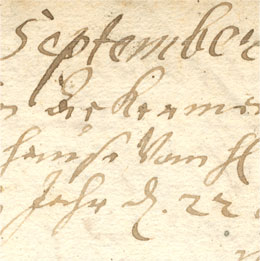What happened to the church clock?
On 16 June 1684, ten days after the great fire that devastated Toompea, the tower of Tallinn’s Church of the Holy Spirit caught fire from a lightning strike. The clock that was mounted on the church’s facade together with the clock’s cartouche that had been carved by Adam Pampe was destroyed in the fire. Work on restoring the tower and the clock began right after the fire.
Did Christian Ackermann make the new clock’s cartouche?
According to the invoices of the churchwarden Heinrich von Geldern, a cabinetmaker and a sculptor were paid to restore the clock. The cabinetmaker Herman Berents was paid 4 riksdalers and the sculptor was paid 10 riksdalers for four evangelists and other carving work. Unfortunately, the sculptor is not mentioned by name.
According to its style, it can nevertheless be assumed that this work was completed in Ackermann’s workshop. There is auricular ornamentation consisting of ‘cartilage’, lobate rolls, and rows of little balls on the new clock’s cartouche. This is the same décor that Ackermann used, together with the ends of little acanthus leaves (on the sides of the square of the clock), for the Simuna Church retable that was also in production in his workshop in 1684.
The clumsiness of the poses of the carved evangelists and the occasional stiffness of the folds in the clothing, primarily in the area of the feet, may indicate that Ackermann did not perform all the work himself but rather that his assistants or apprentices performed part of the work.
The low price paid for the completion of this clock would also indicate, that this was the work of Ackermann’s assistants. Heinrich Martens, who carved the clock of Tallinn’s Cathedral a couple of years later was paid 16 riksdalers for his work, but by that time Ackermann was already a considerably better paid master than Heinrich Martens.
Who constructed the new clock’s clockwork?
It has been believed that the clockmaker Hans Gottfried Starck built the clockwork, but this has been proven to be a false assumption. Starck came to Tallinn later. Andreas Bautz(en) was the municipal clockmaker in the summer of 1684 and although his name is not written on the clockmaking invoices (as is the case for the sculptor as well), it can almost certainly be stated that it had to be the municipal clockmaker who built the new clockwork for the church where Tallinn’s town council held its church services. Additionally, he received an annual salary for the clock’s servicing and maintenance.
How did the error arise in identifying the clockwork’s author?
Hans Gottfried Starck arrived in Tallinn presumably in 1685. He became the next municipal clocksmith in 1689 after Bautz(en)’s death. For some reason, the renovation of the clockwork of the Church of the Holy Spirit was undertaken in 1693 and this job was given in this instance once again to the municipal clockmaker, as can be expected. Based on this contract, it was believed that Starck was the author of the post-fire clockwork as well. Starck built the clockwork for the clock on Tallinn’s Cathedral in 1692.
Much like Ackermann, Starck quarrelled with the masters of the locksmiths’ guild. He did not want to join the guild since he considered his skills to be better than those of the guild members. Yet unlike Ackermann, he ultimately caved in to the pressure and joined Tallinn’s locksmiths’ guild in 1696.
